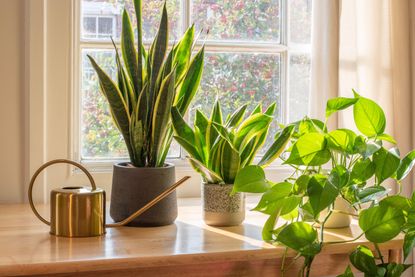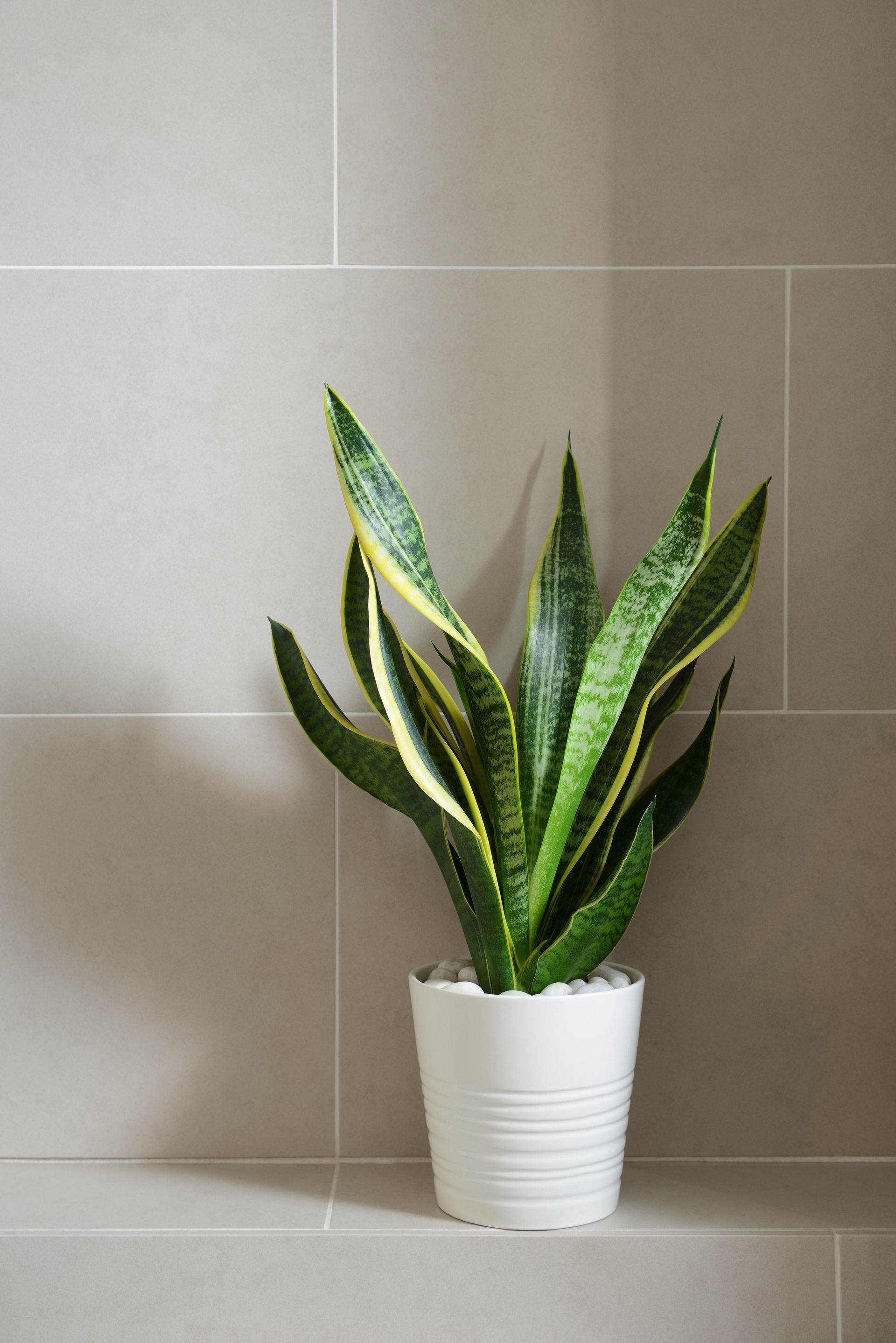6 Common Snake Plant Care Mistakes to Avoid, According to Experts
It might be considered the 'set it and forget it' of the plant world, but there are still some common mistakes to be made when looking after this plant


All of the proud plant parents among us know all too well that tending to plants is a delicate art form, one that can be notoriously difficult to master. No two plants are the same, after all, and what works well for one plant may adversely impact the other.
For that reason, it’s crucial to vary your plant care depending on its highly specific needs, as there's no one-size-fits-all recipe for healthy and happy plants. A great houseplant for beginners, snake plants in particular are highly unique because they actually require much less care than other popular houseplants. Being such low-maintenance plants, gardening expert Richa Kedia says this leaves room for plenty of plant care mistakes.
‘Remember, snake plants are the "set it and forget it" of the plant world,’ she says. ‘A little neglect is actually beneficial for them!’ Here, we spoke to experts to find out more about some of the most common snake plant care mistakes so that we can safeguard against making them in the future.
1. Overwatering

Tempting as it may be to shower your plants in water to keep them hydrated and nourished, the fact is you might actually be damaging your snake plant by drenching it too much. When it comes to watering houseplants, you need to adjust your level depending on the plant. According to Richa Kedia of Simplify Plants, overwatering is one of the most common mistakes snake plant owners make when caring for their snake plants. ‘They dislike soggy feet,’ she says. ‘Water them only when the soil is dry, about every two to three weeks.’
According to Paris Lalicata, Head of Plant Education and Community at The Sill, overwatering snake plants can be highly damaging. 'Since snake plants have succulent-like leaves that help them be drought-tolerant, usually watering them too much is their demise,' she says. 'On the other hand, overwatering can also happen if you’re watering the plant but it’s in super low light or a dark corner. Plants can’t efficiently use water if they aren’t getting enough light so be sure to allow the soil to dry out completely between waterings and place your Snake plant in a window to get plenty of light.'
2. Too much direct sunlight
One of the first things we learn in school biology classes is just how important sunlight is for photosynthesis, so it may seem counterintuitive to worry about over-exposing your snake plant to sunlight, but Richa explains that snake plants are unique in the sense that they have large leaves which are prone to damage when soaked in intense, direct sunlight for long periods at a time. ‘While they enjoy light, harsh sun can scorch their leaves,’ she says. ‘Bright, indirect sunlight is best.’
With that being said, it's important to strike a balance when it comes to providing your snake plant with enough light. Paris explains that snake plants cannot survive in the long term without a light source. 'While Snake plants can tolerate low light conditions, it can be hard to distinguish with the naked eye unless you’re using a light meter to measure, so often plant parents place snake plants too far away from a light source,' she says.
'Snake plants are so resilient because they just take longer to die compared to other plants in low light,' she goes on to say. 'Snake plants actually originate from an environment where they get full sun so they will thrive well in bright light to some direct sunlight. If you give your snake plant adequate light it will grow more vigorously and full.'
3. Poor drainage

The pots that you keep your snake plants in are basically their ventilation system, so it’s crucial that they have good quality pots to thrive. If your current pots aren't up to scratch, purchase new ones that match your home interior and make your houseplants look elevated and expensive. ‘Ensure pots have drainage holes,’ Richa advises. On top of this, the right kind of soil is quite literally the first piece of the puzzle to ensure a strong foundation for your snake plant. ‘Use well-draining soil, as this prevents root rot,’ she adds.
Paris adds that it's important not to upgrade the size of your planters before the snake plant is ready for it. 'Snake plants are slow growers with shallow root systems. At times, plant parents pot them up into containers that are too large before they are ready, which could potentially lead to overwatering/rot due to the overabundance of soil surrounding the roots and keeping them moist,' she explains. 'It’s best to allow Snake plants to get root-bound in their containers before potting them up into containers that are only 1-2 inches larger in diameter.'
4. Overfeeding
It can be tempting to throw everything at your snake plant for the sake of keeping it happy and healthy, but doing so can actually be deeply damaging for it in the long-term. When it comes to using fertilizer, Richa strongly recommends a measured, less-is-more approach. ‘Fertilize sparingly as too much can harm them,’ she says. ‘Once in the growing season is ample.’
5. Neglecting dust

Something that may not immediately cross your mind is just how important it is to clean dust away from leaves when decorating with plants. Snake plants, also known as mother-in-law’s tongue, have thick, sword-like leaves, so it’s easy to see why these can become a breeding ground for dust. ‘Wipe leaves with a damp cloth to keep them dust-free,’ Richa advises.
6. Cold temperatures
Snake plants are a species that's native to Africa, so it should come as no surprise that they are partial to warmer temperatures. Richa explains that while it may be tempting to prop your snake plant up on display against your window, it’s important to take into consideration that this may not be good for the snake plant in the long run, particularly in the colder months. ‘They prefer warmth, so keep them away from draughty windows in winter,' she says.

Price: $30
Features: Stone Planter

Price: $15
Material: Ceramic

Price: $28.99
Size: 1 Gallon
Be The First To Know
The Livingetc newsletter is your shortcut to the now and the next in home design. Subscribe today to receive a stunning free 200-page book of the best homes from around the world.

Katie is a freelance writer and MA student at City, University of London studying Magazine Journalism. Katie discovered her passion for lifestyle journalism after finishing her BA at The University of Oxford, when she started pitching to major lifestyle publications and covering various topics from popular culture to wellness. She is a regular contributor at Well+Good, where she writes experiment-based beauty and fitness pieces.
-
 How to Make a White Bathroom Feel Warm — 5 Tricks Designers Use For a Cozier and More Restful Spaces
How to Make a White Bathroom Feel Warm — 5 Tricks Designers Use For a Cozier and More Restful SpacesGive your all-white bathroom a glow-up with these tips for bringing warmth to the space
By Oonagh Turner Published
-
 5 Habits to Adopt That Will Make Your Home Smell Good All the Time — 'Add Them to Your Routine Today!'
5 Habits to Adopt That Will Make Your Home Smell Good All the Time — 'Add Them to Your Routine Today!'Incorporating these tricks into your maintenance routine will keep every corner of your home smelling fresh and welcoming
By Katie Baxter Published

